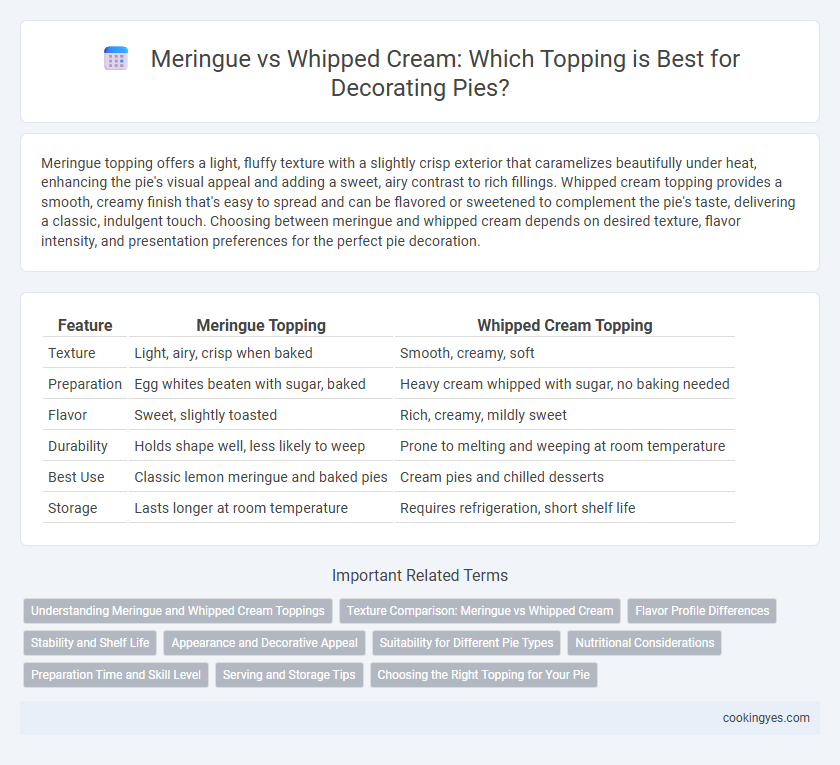Meringue topping offers a light, fluffy texture with a slightly crisp exterior that caramelizes beautifully under heat, enhancing the pie's visual appeal and adding a sweet, airy contrast to rich fillings. Whipped cream topping provides a smooth, creamy finish that's easy to spread and can be flavored or sweetened to complement the pie's taste, delivering a classic, indulgent touch. Choosing between meringue and whipped cream depends on desired texture, flavor intensity, and presentation preferences for the perfect pie decoration.
Table of Comparison
| Feature | Meringue Topping | Whipped Cream Topping |
|---|---|---|
| Texture | Light, airy, crisp when baked | Smooth, creamy, soft |
| Preparation | Egg whites beaten with sugar, baked | Heavy cream whipped with sugar, no baking needed |
| Flavor | Sweet, slightly toasted | Rich, creamy, mildly sweet |
| Durability | Holds shape well, less likely to weep | Prone to melting and weeping at room temperature |
| Best Use | Classic lemon meringue and baked pies | Cream pies and chilled desserts |
| Storage | Lasts longer at room temperature | Requires refrigeration, short shelf life |
Understanding Meringue and Whipped Cream Toppings
Meringue topping consists of whipped egg whites and sugar, creating a light, airy, and slightly crisp texture that browns beautifully when baked, adding visual appeal and a sweet, delicate flavor to pies. Whipped cream topping is made by whipping heavy cream with sugar until soft peaks form, offering a creamy, smooth texture and a rich, slightly sweet taste that complements fruit and custard pies. Understanding these differences helps in selecting the ideal pie topping based on desired texture, sweetness, and presentation.
Texture Comparison: Meringue vs Whipped Cream
Meringue topping on pies offers a light, airy texture with a crisp outer layer that provides a satisfying contrast to the soft pie filling, while whipped cream topping is smooth, creamy, and rich, melting gently on the palate. The meringue's delicate, slightly chewy surface creates a more structured decoration that holds its shape well, whereas whipped cream is softer and often requires refrigeration to maintain stability. Texture preference depends on the desired mouthfeel: meringue adds a crunchy sweetness, while whipped cream delivers a luscious, velvety complement.
Flavor Profile Differences
Meringue topping offers a crisp, sweet, and slightly toasted flavor with a light, airy texture that complements tangy fruit pies like lemon or cherry. Whipped cream topping provides a rich, creamy, and mildly sweet flavor with a smooth, velvety texture ideal for balancing denser, spiced pies such as pumpkin or pecan. The choice between meringue and whipped cream significantly influences the overall taste experience, enhancing either brightness or richness of the pie.
Stability and Shelf Life
Meringue topping offers superior stability and a longer shelf life compared to whipped cream topping, as its baked egg whites resist weeping and maintain structure over time. Whipped cream, being dairy-based, tends to soften and lose firmness quickly, requiring refrigeration and rapid consumption to prevent spoilage. For pie decoration that demands durability and extended freshness, meringue is the optimal choice.
Appearance and Decorative Appeal
Meringue topping creates a glossy, golden-brown finish with stiff peaks that hold intricate shapes, offering a visually striking and elegant appearance for pie decoration. Whipped cream topping provides a soft, fluffy texture with a matte white finish, ideal for a casual, creamy look that complements the pie without overpowering its presentation. The choice between meringue and whipped cream significantly impacts the pie's decorative appeal by balancing structure and softness according to desired visual effects.
Suitability for Different Pie Types
Meringue topping is ideal for lemon meringue and custard pies, as its light, airy texture complements the tartness and adds a toasted finish that enhances visual appeal. Whipped cream topping suits fruit pies like cherry or blueberry, providing a creamy, mildly sweet contrast that balances the pie's natural flavors. Each topping pairs best based on the pie's filling, with meringue offering stability for warm pies and whipped cream enhancing chilled, juicy pies.
Nutritional Considerations
Meringue toppings are lower in fat and calories compared to whipped cream, making them a lighter option for pie decoration. Whipped cream, often high in saturated fat and sugar depending on preparation, provides richer texture but may impact cardiovascular health if consumed excessively. Choosing between the two depends on dietary goals, with meringue offering a protein-rich, egg-white base and whipped cream contributing more calcium and fat content.
Preparation Time and Skill Level
Meringue topping requires whisking egg whites to stiff peaks and careful browning under a broiler, demanding moderate to advanced skill and approximately 15-20 minutes for preparation and finishing. Whipped cream topping involves simple whipping of heavy cream with sugar, taking about 5-10 minutes and suitable for beginners due to its ease and minimal technique. Choosing between these toppings depends on the desired presentation effort and the baker's comfort with meringue's delicate preparation versus whipped cream's straightforward process.
Serving and Storage Tips
Meringue topping requires baking to achieve a light, crisp texture that holds well on pies, making it ideal for same-day serving and best consumed within 24 hours to avoid weeping. Whipped cream topping offers a soft, creamy finish that should be chilled and served immediately, as it tends to lose stability and can separate if stored for more than a few hours. For optimal freshness, meringue-topped pies can be stored at room temperature briefly, while whipped cream-topped pies must be refrigerated and covered to prevent moisture absorption and maintain texture.
Choosing the Right Topping for Your Pie
Meringue topping offers a light, airy texture with a crisp, golden finish that enhances fruit pies by adding subtle sweetness and visual appeal. Whipped cream topping provides a creamy, smooth contrast that complements rich, custard-based pies and allows for easy flavor customization with vanilla or spices. Selecting the right pie topping depends on the pie filling's flavor profile and desired texture balance, ensuring a harmonious dessert experience.
Meringue Topping vs Whipped Cream Topping for Pie Decoration Infographic

 cookingyes.com
cookingyes.com